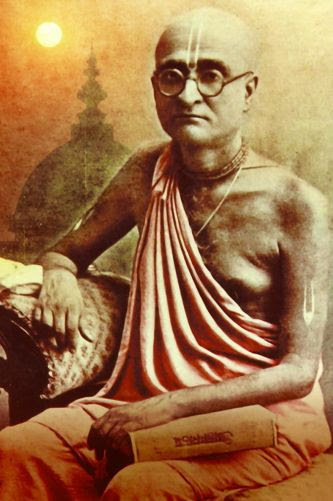śrī śrī guru gaurāṅga jayataḥ!

Year 13, Special Edition
Posted: 3 January 2021
Dedicated to
nitya-līlā praviṣṭa oṁ viṣṇupāda
Śrī Śrīmad Bhakti Prajñāna Keśava Gosvāmī Mahārāja
Inspired by and under the guidance of
Śrī Śrīmad Bhaktivedānta Nārāyaṇa Gosvāmī Mahārāja
Guru-tattva – Rādhā-tattva
by Śrīla Bhaktisiddhānta Sarasvatī Ṭhākura Prabhupāda
Appearing in English for the first time

śrī śrī guru-gaurāṅga jayataḥ
Camp: 41 Theatre Road,
Kalikātā
1st of Āśvina, 1341
18th of September, 1934
Sneha-vigraheṣu (“personified object of my affection”),
I received your letter dated the 13th. You have invoked a conceptional whirlpool of apparent contradiction in regards to guru-tattva.
The destructible world is manifest from Bhagavān’s external potency (bahiraṅga-śakti), wherein the three modes are active. And the eternal realm is manifest from His internal potency (cit-śakti). There, the three śaktis – hlādinī, sandhinī and samvit 1– are active at every moment.
-----
1 Hlādinī – pleasure, sandhinī – existence, and samvit – cognizance.
The world manifest from cit-śakti and the world created by acit-śakti (external potency) are characteristically different. The jīva’s svarūpa (intrinsic form and nature) is a manifestation that is both different and non-different from Bhagavān (bhedābheda-prakāśa) and it arises from Bhagavān’s taṭasthā-śakti (marginal potency).
These three śaktis of Bhagavān are eternal. When the jīva manifest from taṭasthā-śakti becomes an enjoyer in the non-eternal (anitya) material existence, he does not perceive Guru-pādapadma as being identical with the object of service (Bhagavān). Although eternally situated in cit-śakti, Gurudeva is visible to many jīvas as situated in taṭasthā-śakti.
When one’s bhajana has fully matured, Anaṅga Mañjarī is recognized as a tattva identical to the object of her service, Śrī Vārṣabhānavī [Śrī Rādhā]. That is to say, Śrī Vārṣabhānavī is the original form2 of the āśraya-vigraha (the embodiment of love for Kṛṣṇa), and Anaṅga Mañjarī is the original manifestation3 of that form – the āśrayānuga-vigraha [that embodiment of love for Kṛṣṇa who is in the anugatya of the original form, Śrī Rādhā] – manifest to reveal the svarūpas of the liberated jīvas.
-----
2 svayaṁ-rūpā – original form.
3 svayaṁ prakāśa – original manifestation.
By some good fortune, when the liberated jīva goes to the banks of the kuṇḍa [Rādhā-kuṇḍa], he internalizes within madhura-rati all the many forms of love. Instead of referring to bhedābheda-prakāśa Śrī Guru-pādapadma4 as svayaṁ-prakāśa [an original manifestation] in madhura-rati, he beholds, consecutively, the facets of the original form [svayaṁ-rūpā – Śrī Rādhā] and the original manifestation [svayaṁ-prakāśa – Anaṅga Mañjarī].
-----
4 A manifestation that is both different and non-different from the original āśraya-vigraha, Śrī Rādhā
If one examines [Śrīla Narottama] Ṭhākura Mahāśaya’s statements like guru-rūpā sakhī bāme5 and others, it becomes apparent that the sakhīs are direct bodily manifestations (kāya-vyuha) of Śrī Vārṣabhānavī and non-different from Her.
-----
5 “Guru-rūpā sakhī-bāme, tribhaṅga bhaṅgimā ṭhāme, cāmarera bātāsa kariba – with my guru-sakhī on my left side, I will take the cāmara and fan Kṛṣṇa’s three-fold bending form” (Prārthanā 5.11).
Eternally your well-wisher,
Śrī Siddhānta Sarasvatī





